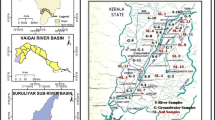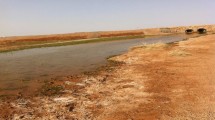Abstract
Salination and saltwater intrusion are common and increasing problems in coastal areas. This study investigates the susceptibility of soils and water resources to saline intrusion in the coastal areas of Cambodia in the context of climate change. Water samples were collected from tube wells (n = 8), dug wells (n = 25), canals (n = 7), ponds (n = 5), and rain water (n = 5) across the Koh Kong coastal area of Cambodia and measured for the contaminants of health concerns (As, Ba, NO3−, NO2−, F−, and Mn) and esthetic quality (Cu, Fe, and Zn) following USEPA methods. Water salinity and other physicochemical properties (Temperature, pH, ORP, conductivity, TDS, turbidity, and DO) were measured onsite using field instruments. Concurrently, surface agricultural soils were sampled at each site. Soil salinity was determined by soil/water extract method following a standard protocol. Analytical results revealed that approximately 12.5% of tube wells, 4% of dug wells, and 20% ponds were saline. Concurrently, 37.5% of tube wells and 58.4% of dug wells contained As greater than 10 μg L−1, exceeded WHO’s Drinking Water Quality Guideline. Geogenic barium, iron, and manganese groundwater contamination also was widespread regionally. Anthropogenic contaminants like nitrate and nitrate (from agricultural runoff) were lower, well Cambodian Drinking Water Quality Standards. Most of soil pH was in acidic condition. Most of agricultural soils in Koh Kong coastal area are not saline, but the agricultural fields close to coastline and/or in the estuarine are frequently saline. This study suggested that appropriate water treatment technologies are needed to provide safe drinking water to people residing in Koh Kong coastal areas, and that it is important to manage salinity to prevent future contamination. Moreover, adaptation actions should be further promoted in order to cope with the potential impacts of the climate change in this Koh Kong coastal area.

Similar content being viewed by others
Data availability
All data are presented in this manuscript.
References
Catalin, S. (2014). Groundwater vulnerability in Vietnam and innovative solutions for sustainable exploitation. Journal of Vietnamese Environment, 6(1), 13–21.
Delpla, I., Jung, A. V., Baures, E., Clement, M., & Thomas, O. (2009). Impacts of climate change on surface water quality in relation to drinking water production. Environment International, 35, 1225–1233.
Han, D., & Currell, M. J. (2018). Delineating multiple salinization processes in a coastal plain aquifer, northern China: Hydrochemical and isotopic evidence. Hydrology and Earth System Sciences, 22, 3473–3491. https://doi.org/10.5194/hess-22-3473-2018
Hardie, M., Doyle, R. 2012. Measuring soil salinity: In Sergey Shabala, S and Cuin, T.A. (Edit). Plant Salt Tolerance, Methods and Protocols, Springer New York Heidelberg Dordrecht London
Hens, L., Vromant, N., Tho, N., & Hung, N. T. (2009). Salination of surface water, groundwater, and soils in the shrimp farming areas of the coastal Cai Nuoc district, South Vietnam. International Journal of Environmental Studies, 66, 69–81. https://doi.org/10.1080/00207230902760192
Isa, N. M., Aris, A. Z., Lim, W. Y., Wan Sulaiman, W. N. A., & Praveena, S. M. (2014). Evaluation of heavy metal contamination in groundwater samples from Kapas Island, Terengganu, Malaysia. Arabian Journal of Geosciences, 7, 1087–1100. https://doi.org/10.1007/s12517-012-0818-9
Johnsen, S., Munford, G. 2012. European Union Delegation to Cambodia “Country Environment Profile.”.http://eeas.europa.eu/archives/delegations/cambodia/documents/publications/country_env_profile_cam_april_2012_en.pdf Accessed on 29 Nov 2018
Kocar, B. D., Polizzotto, M. L., Benner, S. G., Ying, S. C., Ung, M., Ouch, K., Samrith, S., Suy, B., Phan, K., Sampson, M., & Fendorf, S. (2008). Integrated biogeochemical and hydrologic processes driving arsenic release from shallow sediment to the Mekong Delta. Cambodia Applied Geochemistry, 23(11), 3059–3071.
Mao, C., Tan, H., Song, Y., & Rao, W. (2020). Evolution of groundwater chemistry in coastal aquifers of the Jiangsu, east China: Insights from a multi-isotope (δ2H, δ18O, 87Sr/86Sr, and δ11B) approach. Journal of Contaminant Hydrology, 235, 103730. https://doi.org/10.1016/j.jconhyd.2020.103730
McFarlane, D., Stone, R., Martens, S., Thomas, J., Silberstein, R., Ali, R., & Hodgson, G. (2012). Climate change impacts on water yields and demands in south-western Australia. Journal of Hydrology., 475, 488–498.
McSweeney, C., New, M. &Lizcano, G. 2010. UNDP Climate Change Country Profiles: Cambodia. Available: https://www.geog.ox.ac.uk/research/climate/projects/undp-cp/UNDPCCCP_documentation.pdf Accessed date: Apr 25, 2021
MIME, 2004. Drinking water quality standards, Ministry of Industry Mine and Energy, Phnom Penh, Cambodia
NCCC. 2013. Cambodian climate change strategic plan 2014–2023. National Climate Change Committee, Royal Government of Cambodia, Phnom Penh, Cambodia
Papacostas, N. C., Bostick, B. C., Quicksall, A. N., Landis, J. D., & Sampson, M. (2008). Geomorphic controls on groundwater arsenic distribution in the Mekong River Delta. Cambodia Geology, 36(11), 891–894.
Park, S. C., Yun, S. T., Chae, G. T., Yoo, I. S., Shin, K. S., Heo, C. H., & Lee, S. K. (2005). Regional hydrochemical study on salinization of coastal aquifers, western coastal area of South Korea. Journal of Hydrology, 313(3–4), 182–194. https://doi.org/10.1016/j.jhydrol.2005.03.001
Park, Y., Lee, J. Y., Kim, J. H., & Song, S. H. (2012). National scale evaluation of groundwater chemistry in Korea coastal aquifers: Evidences of seawater intrusion. Environmental Earth Sciences, 66, 707–718. https://doi.org/10.1007/s12665-011-1278-3
Phan, K., Phan, S., Huoy, L., Suy, B., Wong, M. H., Hashim, J. H., Mohamed Yasin, M. S., Aljunid, S. M., Sthiannopkao, S., & Kim, K.-W. (2013). Assessing mixed trace elements in groundwater and their health risk of residents living in the Mekong River basin of Cambodia. Environmental Pollution, 182c, 111–119.
Polizzotto, M. L., Kocar, B. D., Benner, S. G., Sampson, M., & Fendorf, S. (2008). Near-surface wetland sediments as a source of arsenic release to ground water in Asia. Nature, 454(7203), 505–508.
Putranto, T. T., Widiarso, D. A., & Susanto, N. (2017). Assessment of groundwater quality to achieve sustainable development in Semarang Coastal Areas. IOP Conference Series: Earth and Environmental Science, 79, 012001.
Rizvi, A. R., & Singer, U. (2011). Cambodia coastal situation analysis (p. 58). IUCN.
Shi, L., & Jiao, J. J. (2014). Seawater intrusion and coastal aquifer management in China: A review. Environment and Earth Science, 72, 2811–2819. https://doi.org/10.1007/s12665-014-3186-9
Sigrist M. 2008. Groundwater contamination in Asian coastal cities: Case study of Ho Chi Minh City, Vietnam. In: Takizawa S. (eds) Groundwater Management in Asian Cities. cSUR-UT Series: Library for Sustainable Urban Regeneration, vol 2. Springer, Tokyo. https://doi.org/10.1007/978-4-431-78399-2_13
Sokuntheara, C. 2014. Seawater intrusion along coastal line in Krong Preah Sihanouk of Kingdom of Cambodia, Project report on CCOP-GSJ/AIST-GA Groundwater Phase II Project Final Meeting, 18–20 March 2014, Bandung, Indonesia
Tibby, J., & Tiller, D. (2007). Climate-water quality relationships in three western Victorian (Australia) lakes 1984–2000. Hydrobiologia, 591(1), 219–234.
USEPA. 2018. Climate change impacts on water resources. https://19january2017snapshot.epa.gov/climate-impacts/climate-impacts-water-resources_.html#Quality Accessed on 28 Nov 2018
USGS. 2019. U.S. Geological Survey. https://www.usgs.gov/special-topic/water-science-school/science/saline-water-and-salinity?qt-science_center_objects=0#qt-science_center_objects Accessed on 1 Dec 2019
Van Vliet, M. T. H., & Zwolsman, J. J. G. (2008). Impact of summer droughts on the water quality of the Meuse river. Journal of Hydrology, 353(1–2), 1–17.
Vann, S., Puttiwongrak, A., Suteerasak, T., & Koedsin, W. (2020). Delineation of seawater intrusion using geo-electrical survey in a coastal aquifer of Kamala Beach, Phuket Thailand. Water, 12, 506. https://doi.org/10.3390/w12020506
WHO, 2011. Guideline for drinking water quality, 4th Ed, World Health Organization (WHO), Geneva
Xiong, G.-Y., Chen, G. Q., Xu, X. Y., Liu, W. Q., Fu, T. F., Khokiattiwong, S., Kornkanitnan, N., Seddique, A. A., Shi, X. F., Liu, S. F., Su, Q., & Xu, X. L. (2020). A comparative study on hydrochemical evolution and quality of groundwater in coastal areas of Thailand and Bangladesh. Journal of Asian Earth Sciences, 195, 104336. https://doi.org/10.1016/j.jseaes.2020.104336
Acknowledgements
The authors would like to thank the Ministry of Science and Technology in South Korea through the International Environmental Research Institute (IERI) of Gwangju Institute of Science and Technology (GIST) for providing us with the funds in 2019 that facilitated the delivery of the Program. We also would like to thank Benjamin Bostick for his assistance in improving the English fluency in the manuscript and student research assistants of the Faculty of Science and Technology of International University for their field and lab assistances. All reviewers provided interesting and useful comments to improve this manuscript.
Funding
This study was supported by the Ministry of Science and Technology in South Korea through the International Environmental Research Institute (IERI) of Gwangju Institute of Science and Technology (GIST), Republic of Korea.
Author information
Authors and Affiliations
Contributions
Phan, K. and Chek, S. conceptualized and wrote the manuscript. Kim, K-W., Eav, C., and Sieng, H. reviewed and revised the MS. Eav, C. and Phan, K. performed the data analysis and graphing.
Corresponding author
Ethics declarations
Ethics Approval and Consent to Participate
Not Applicable.
Consent for Publication
All authors read and approved the content of the final manuscript.
Conflict of Interest
The authors declare no competing interests.
Additional information
Publisher's Note
Springer Nature remains neutral with regard to jurisdictional claims in published maps and institutional affiliations.
Rights and permissions
About this article
Cite this article
Phan, K., Chek, S., Eav, C. et al. Assessing Salinization and Water Quality in Koh Kong Coastal Areas of Cambodia: Potential Impacts of Climate Change. Water Air Soil Pollut 232, 510 (2021). https://doi.org/10.1007/s11270-021-05462-z
Received:
Accepted:
Published:
DOI: https://doi.org/10.1007/s11270-021-05462-z




